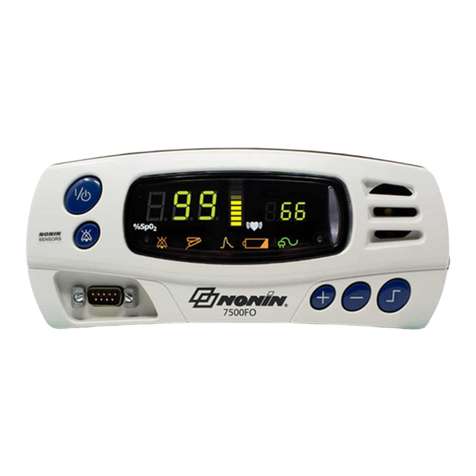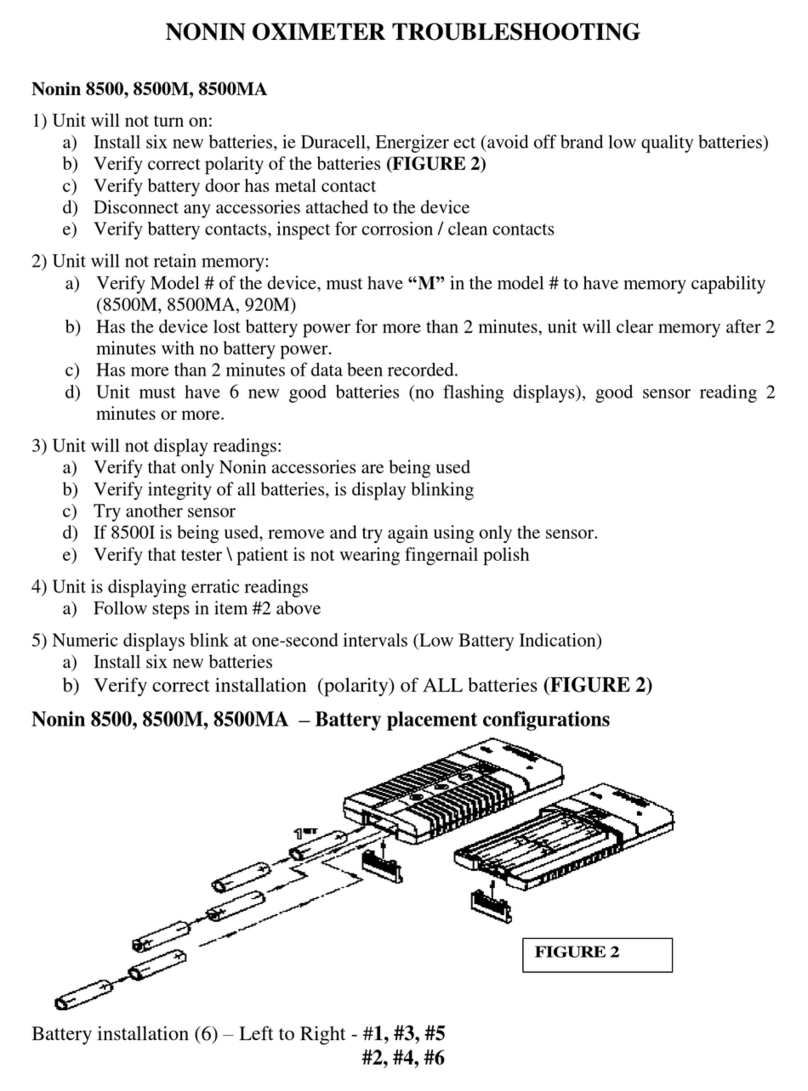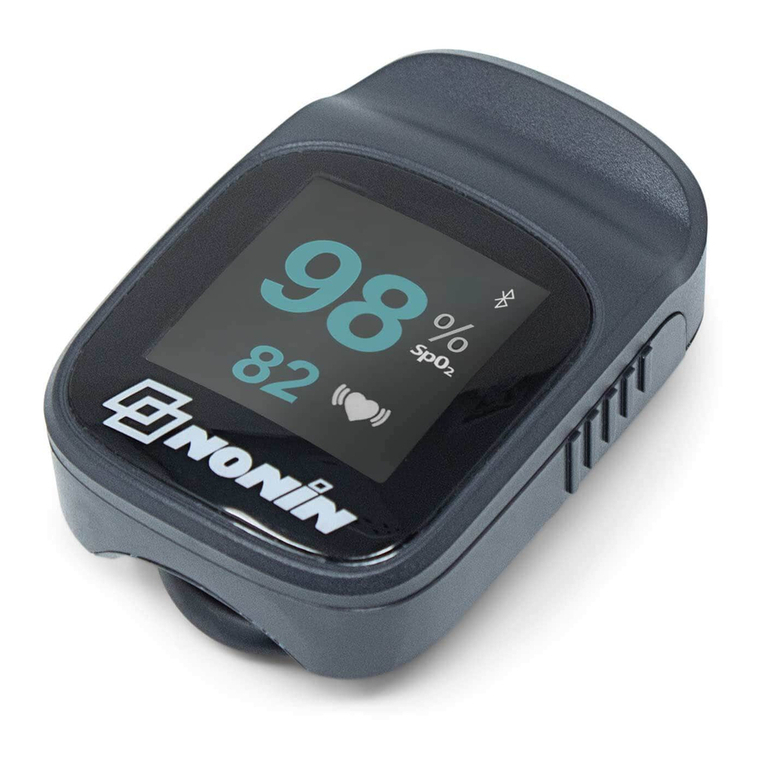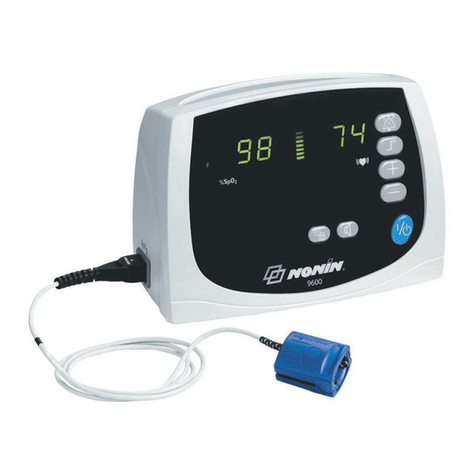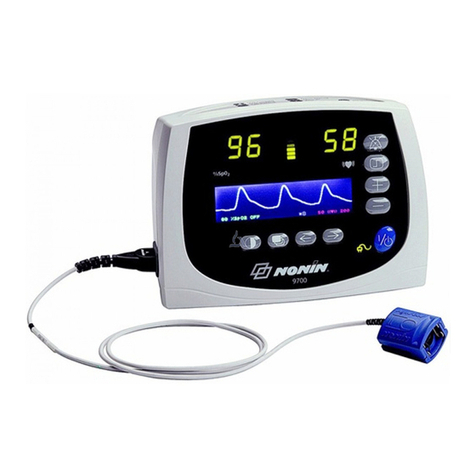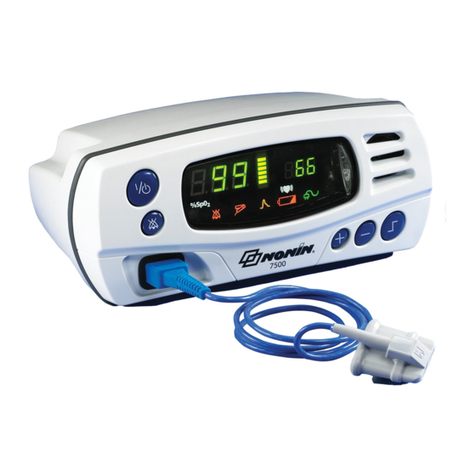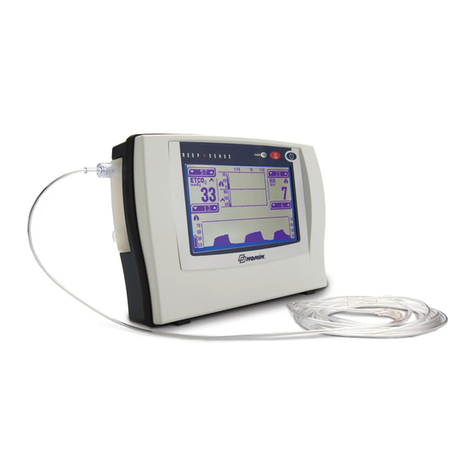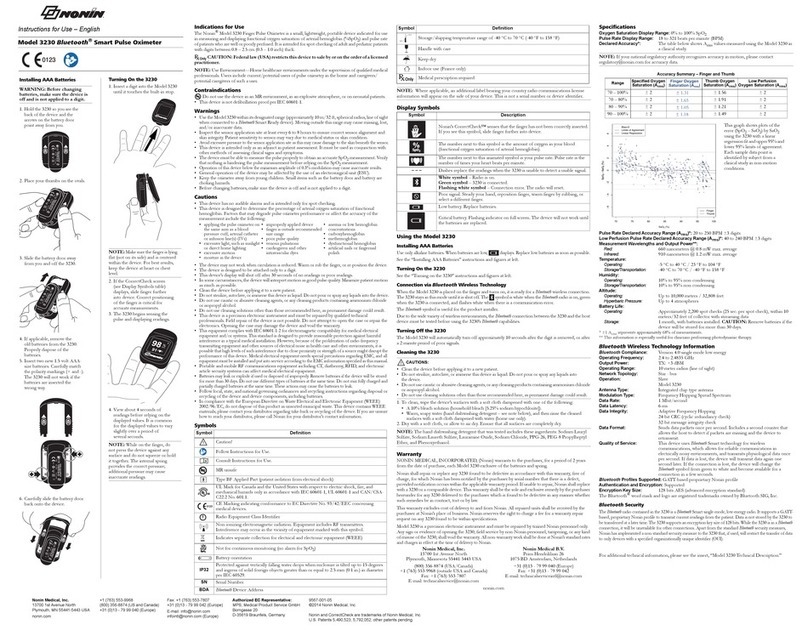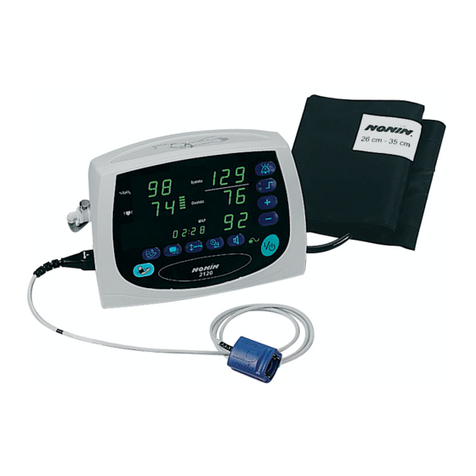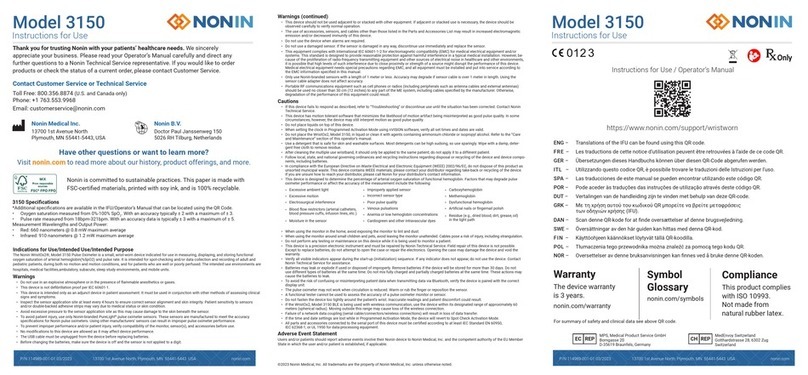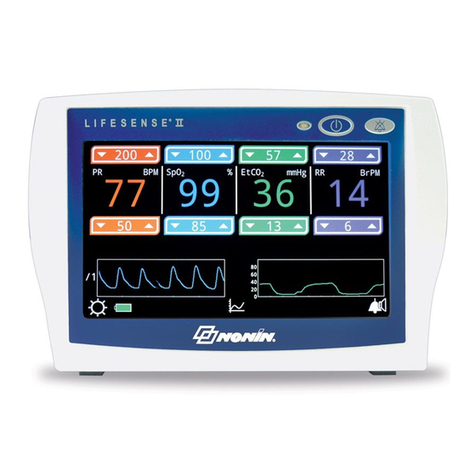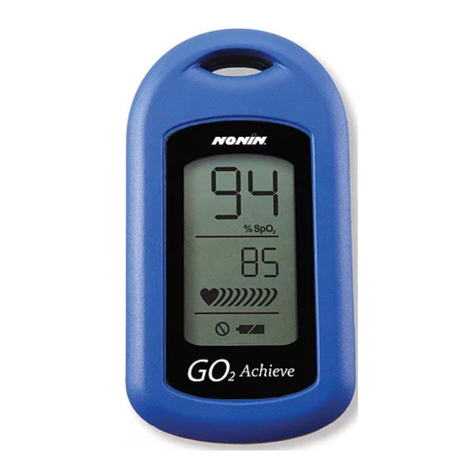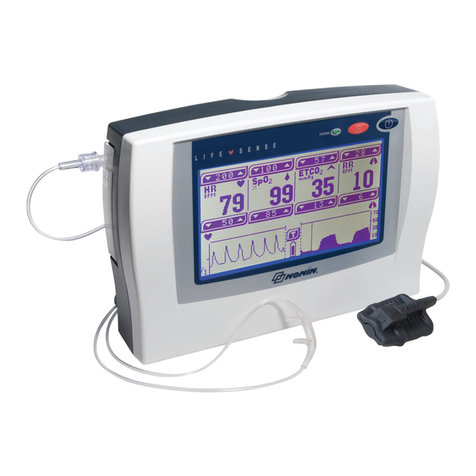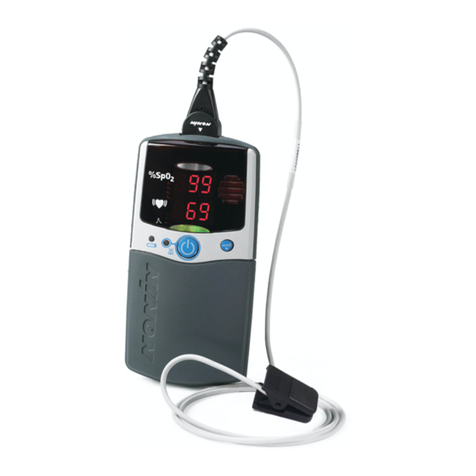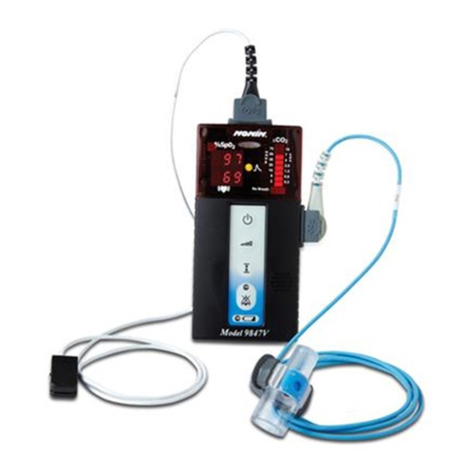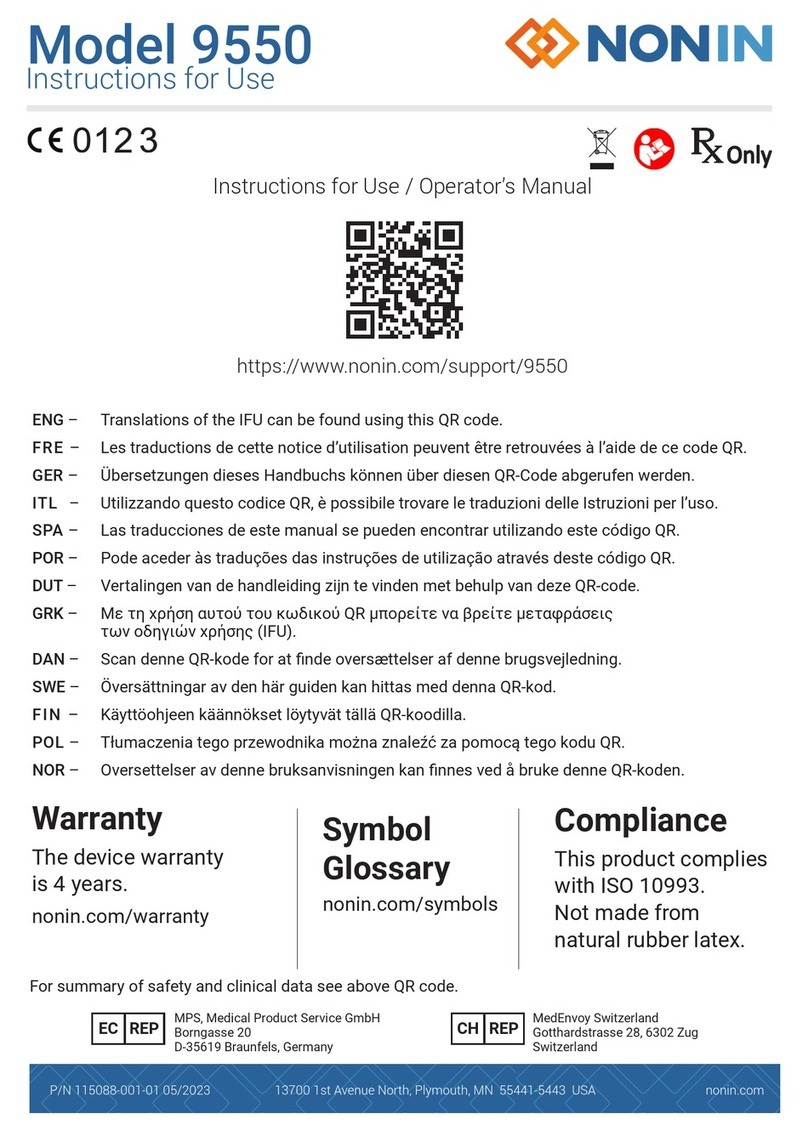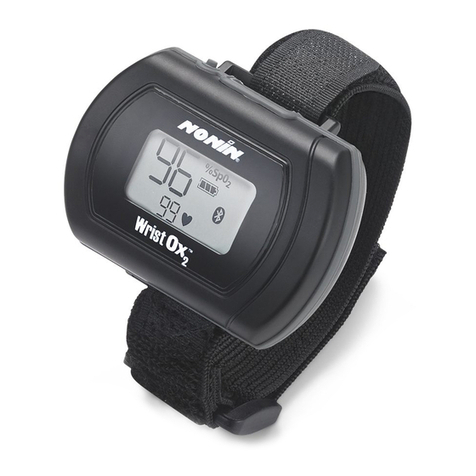
8339-001-07
© 2019 Nonin Medical, Inc.
MPS, Medical Product Service GmbH
Borngasse 20
D-35619 Braunfels, Germany
Nonin and Onyx are registered trademarks of Nonin Medical, Inc.
U.S. Patents 5,490,523; 5,792,052
Nonin Medical, Inc.
13700 1st Avenue North
Plymouth, Minnesota 55441 USA
+1 (763) 553-9968 (outside US and Canada)
+
31 (0)13 - 79 99 040
(Europe)
(800) 356-8874 (US and Canada)
Fax: +1 (763) 553-7807
+31 (0)13 - 79 99 042 (Europe)
nonin.com
Instructions for Use—English
Onyx®Vantage 9590 Finger Pulse Oximeter
Indications for Use
The Nonin®Onyx Vantage 9590 Finger Pulse Oximeter is a small, lightweight, portable device indicated for use in measuring
and displaying functional oxygen saturation of arterial hemoglobin (%SpO2) and pulse rate of patients who are well or poorly
perfused. It is intended for spot-checking of adult and pediatric patients on digits (fingers, thumb, toes) that are between 0.3–
1.0 inch (0.8 – 2.5 cm) thick. The device’s intended use environments include hospitals, clinics, long-term care facilities,
skilled nursing facilities, emergency medical services, and home healthcare services.
CAUTION: Regulatory authorities outside the U.S. recognize the use of this device in motion conditions.
Warnings
• Do not use the device in an MR environment, in an explosive atmosphere, or on neonatal patients.
• This device is not defibrillation proof per IEC 60601-1.
• Inspect the sensor application site at least every 4 hours to ensure correct sensor alignment and skin integrity. Patient sensitivity to
the sensor may vary due to medical status or skin condition.
• Avoid excessive pressure to the sensor application site as this may cause damage to the skin beneath the sensor.
• This device is intended only as an adjunct in patient assessment. It must be used in conjunction with other methods of assessing
clinical signs and symptoms.
• The device must be able to measure the pulse properly to obtain an accurate SpO2measurement. Verify that nothing is hindering the
pulse measurement before relying on the SpO2measurement.
• Operation of this device below the minimum amplitude of 0.3% modulation may cause inaccurate results.
• General operation of the device may be affected by the use of an electrosurgical unit (ESU).
• This device should not be used adjacent to or stacked with other equipment. If adjacent or stacked use is necessary, the device should
be observed carefully to verify normal operation.
• Keep the oximeter away from young children. Small items such as the battery door, battery, and lanyard are choking hazards.
• Certain activities may pose a risk of injury, including strangulation, if lanyard should become wrapped around your neck.
• Before changing batteries, make sure the device is off and is not applied to a digit.
• Portable RF communications equipment such as cell phones or radios (including peripherals such as antenna cables and external
antennas) should be used no closer than 30 cm (12 inches) to any part of the ME system, including cables specified by the
manufacturer. Otherwise, degradation of the performance of this equipment could result.
Cautions
• This device has no audible alarms and is intended only for spot-checking.
• This device is designed to determine the percentage of arterial oxygen saturation of functional hemoglobin. Factors that may degrade
pulse oximeter performance or affect the accuracy of the measurement include the following:
• The device may not work when circulation is reduced. Warm or rub the finger, or re-position the device.
• This device’s display will go blank after 30 seconds of no readings or poor readings.
• In some circumstances, the device may interpret motion as good pulse quality. Minimize patient motion as much as possible.
• Clean the device before applying it to a patient.
• Do not sterilize, autoclave, or immerse this device in liquid. Do not pour or spray any liquids onto the device.
• Do not use caustic or abrasive cleaning agents, or any cleaning agent containing ammonium chloride.
• This device is a precision electronic instrument and must be repaired by Nonin Technical Service. Field repair of the device is not
possible. Do not attempt to open the case or repair the electronics. Opening the case may damage the device and void the warranty.
• A flexible circuit connects the two halves. Do not twist or pull the flexible circuit or overextend the device’s spring. Do not hang the
lanyard from the device’s flexible circuit.
• A functional tester cannot be used to assess the accuracy of a pulse oximeter monitor.
• This equipment complies with IEC 60601-1-2 for electromagnetic compatibility for medical electrical equipment and/or systems. This
standard is designed to provide reasonable protection against harmful interference in a typical medical installation. However, because
of the proliferation of radio-frequency transmitting equipment and other sources of electrical noise in healthcare and other
environments, it is possible that high levels of such interference due to close proximity or strength of a source might disrupt the
performance of this device. Medical electrical equipment needs special precautions regarding EMC, and all equipment must be
installed and put into service according to the EMC information specified in this manual.
• Batteries may leak or explode if used or disposed of improperly. Remove batteries if the device will be stored for more than 30 days.
Do not use different types of batteries at the same time. Do not mix fully charged and partially charged batteries at the same time.
These actions may cause the batteries to leak.
• Follow local, state, and national governing ordinances and recycling instructions regarding disposal or recycling of the device and
device components, including batteries.
• In compliance with the European Directive on Waste Electrical and Electronic Equipment (WEEE) 2002/96/EC, do not dispose of this
product as unsorted municipal waste. This device contains WEEE materials; please contact your distributor regarding take-back or
recycling of the device. If you are unsure how to reach your distributor, please call Nonin for your distributor’s contact information.
• When using the device in the home, avoid exposing the device to lint and dust.
• do not apply the pulse oximeter on the
same arm as a blood pressure cuff,
arterial catheter or infusion line(s) (IVs)
• excessive light, such as sunlight or direct
home lighting
• excessive motion
• moisture in the device
• improperly applied device
• finger is outside recommended size
range
• poor pulse quality
• venous pulsations
•
anemia or low hemoglobin concentrations
• cardiogreen and other intravascular dyes
• carboxyhemoglobin
• methemoglobin
• dysfunctional hemoglobin
• artificial nails or fingernail polish
• residue (e.g., dried blood, dirt, grease, oil)
in the light path





